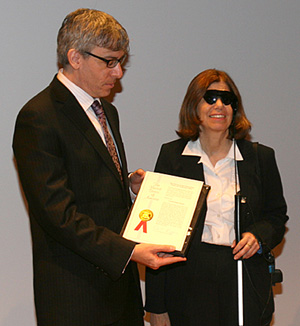News and Events
News Brief
Funded by National Eye Institute, Makers of Bionic Eye Receive Eight Millionth Patent
By Dustin C. Hays
Science Writer
The Argus II retinal prosthesis, developed by Second Sight, Inc., with funding from the National Eye Institute (NEI), was recognized September 8, 2011, in honor of being the 8 millionth patent issued by the United States Patent and Trademark Office (USPTO). The Argus II is a device that restores limited sight to the blind.
"I'd like to thank Second Sight for inspiring us all to keep dreaming, testing, experimenting and patenting-and for demonstrating that patented American ingenuity will continue to drive our nation's growth," said David J. Kappos, USPTO Director, at the celebration which took place at the original U.S. patent office building, once known as the "temple of invention" and now occupied by the Smithsonian American Art Museum.
The Argus II consists of a miniature video camera, inconspicuously mounted on a pair of sunglasses. A belt-worn processing unit converts images captured by the camera into electrical impulses that are wirelessly transmitted to a 60-electrode grid implanted in the eye. Users perceive the electrical impulses as patterns of light that produce visual information.
"I feel like I won my own personal lottery," said Argus II user Barbara Campbell, recounting the invitation to participate in a clinical trial of the device. Campbell has been using the device to get around Manhattan, where she works as a rehabilitation counselor at the New York State Office of Children and Family Services.

Robert J. Greenberg, M.D., Ph.D., Second Sight’s president/CEO and Barbara Campbell, Argus II user.
Campbell has a genetic disease called retinitis pigmentosa (RP), which causes gradual decline of vision due to death of photoreceptor cells. She has been wearing the Argus II device for about 3 years. She said the device greatly increases her mobility and safety, allowing her to see crosswalk lines and find her bus stop. Campbell told the audience she can even read large print.
"Second Sight's retinal prosthesis is giving improved mobility and independence to people who are blind from RP and have no other options for restoring any of their vision," said Paul Sieving, M.D., Ph.D., director of the National Eye Institute (NEI). "It is encouraging to see this highly innovative technology being used to help people with their activities of daily living."
"One important component of our ability to accomplish this goal has been direct government support from the National Eye Institute. This would not have been possible without government grant support," said Robert J. Greenberg, M.D., Ph.D., Second Sight's president and CEO. His company now holds 90 patents related to sight restoration. Since 2001, the NEI has contributed more than $26 million to Second Sight for development of the Argus II and associated technologies. The investment has not only rendered the world a device to help the blind see but has pushed the field of bioengineering by providing novel materials and techniques for interfacing prosthetic devices with the central nervous system.
The Argus II was approved for sale in Europe earlier this year and is expected to be approved soon by the FDA. The device will sell for about $100,000. Second Sight is currently developing a next-generation 256-electrode retinal grid that should give users much greater resolution.

The Argus II consists of a miniature video camera mounted on a pair of sunglasses and a belt-worn processing unit.
Kappos used the celebration to urge the U.S. Senate to pass the American Invents Act, which he claimed would expedite patent application processing, drive down the backlog of unexamined patents, and result in higher-quality patents less likely to be challenged in court. "Right now, the U.S. Senate has the power to send to the President the America Invents Act, a patent reform bill that will optimize our nation's innovation system by promoting clearer and more certain intellectual property rights," said Kappos. His passionate argument seemed to have swayed lawmakers. Later that day the bill was approved by the Senate. President Obama signed the act September 16, 2011.
The Smithsonian American Art Museum, in collaboration with the USPTO, is currently exhibiting "The Great Hall of American Wonders," celebrating American innovation. Beginning November 11, the museum will host "Building a Better Mousetrap," a display of 32 patent models from private collector Alan Rothschild.
For more information about Second Sight, Inc., visit www.2-sight.eu.
For more information about the USPTO, visit www.uspto.gov.
For more information about the Smithsonian American Art Museum, visit www.americanart.si.edu
Posted: September 22, 2011

